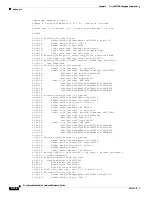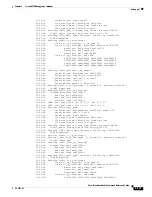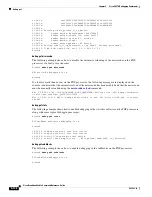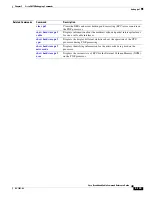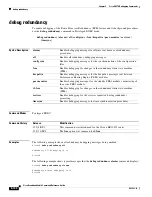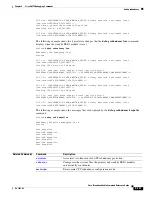
6-8
Cisco Broadband Cable Command Reference Guide
OL-1581-07
Chapter 6 Cable CPE Commands
cable-modem dhcp-proxy
Usage Guidelines
This command is useful in three situations:
•
When the router is configured for routing mode, an IP address must be assigned to its Ethernet
interface. Without the
cable-modem dhcp-proxy
command, this IP address must be a static IP
address assigned either by using a Cisco IOS configuration file or by manually entering the
necessary interface configuration CLI commands. The
cable-modem dhcp-proxy
command allows
a DHCP server to assign an IP address to the Ethernet interface.
•
When NAT is used, an inside global address pool must be created on the Ethernet interface. Without
the
cable-modem dhcp-proxy
command, this must be done by specifying a static IP address in the
ip nat pool
pool-name
start-ip
end-ip
netmask
subnet
command. The
cable-modem dhcp-proxy
command allows a DHCP server to assign an IP address that automatically creates the NAT address
pool.
When using this option, you must also use the following NAT configuration commands:
–
Use the
ip nat inside
command in interface configuration mode to configure the Ethernet
interface as the inside interface.
–
Use the
ip nat outside
command in interface configuration mode to configure the cable
interface as the outside interface.
–
Specify the
overload
option with the
ip nat
command in global configuration mode to
implement Port Address Translation (PAT) so that multiple PCs can use the single IP address in
the NAT pool created by the
cable-modem dhcp-proxy
command.
•
When using the Cisco Easy VPN feature to create a VPN tunnel, the command allows a static
address to be used for the tunnel’s creation.
After configuring the router with the
cable-modem dhcp-proxy
command, reboot the router. During the
DOCSIS provisioning process, the router sends a DHCP client request to obtain an IP address for the
cable interface.
The router then sends a proxy DHCP request to the DHCP server using the Ethernet interface’s MAC
address. The DHCP server replies with a second IP address that the router assigns to either the Ethernet
or loopback interface, or to the NAT pool, depending on which option was used in the
cable-modem
dhcp-proxy
command.
Note
When replying to the proxy request for the Ethernet interface, the DHCP server should assign an IP
address that is on the same network as the customer premises equipment (CPE) devices that are attached
to the router’s Ethernet interface.
Tip
If you have configured a Cisco CM for routing mode and are also using the
cable-modem dhcp-proxy
nat
command on the CM, you must configure the corresponding cable interface on the Cisco CMTS with
the
cable dhcp-giaddr policy
command.
Using NAT and DHCP Proxy and Copying Configuration Files
Most service providers typically create a standard configuration file for their cable modems, verify it,
and then copy the working configuration as needed to other cable modems. This can cause problems
when using the
cable-modem dhcp-proxy
command to create a NAT address pool for NAT/PAT
translation.

